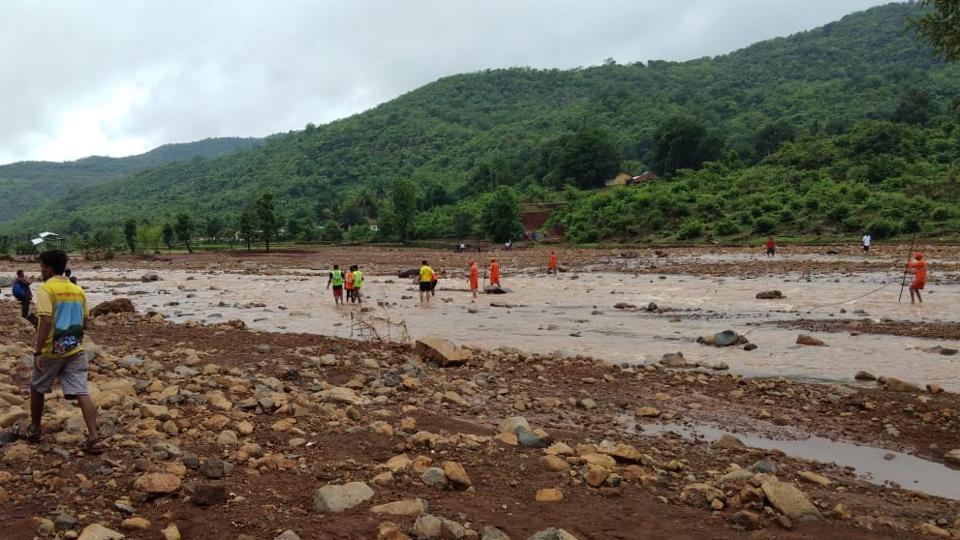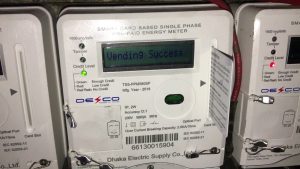July 6, 2019 SANDRP
Late that night of July 2, shouts of “Dharan Futla, Dharan Futla” (The dam has breached!) saved the already-scared 62-year-old Narayan Gaikwad and his family, as the family ran to a nearby hill. Tivare Dam (Longitude: 73° 42′ 0″; Latitude: 17° 36′ 0″ as per CWC’s National Register of Large Dams), across a rivulet in the Vashishthi Basin of coastal Maharashtra breached around 9.30 pm on July 2, 2019, taking 24 men, women and children with its fury.
But how many and how much of Maharashtra would be saved considering the fact that Maharashtra has India’s highest number of large dams, BY FAR? And especially considering the serious questions this episode is raising about the absolute lack of accountability of the government dam establishment.
These questions become pertinent for Konkan region of Maharashtra, where Tivare was located as this region faces highest rainfalls in the state, steepest slopes and is tainted with several incomplete, illegal, inefficient dams which are posing a risk to humans and environment. SANDRP had published a report on incomplete and illegal dams in Konkan region 3 years back [ii]. High Court, SIT Committee Report headed by Madhavrao Chitale and even CAG had singled out dams in Konkan for their inefficiency and violations at multiple levels. The situation remains the same till date. Experts and past dam bureaucrats put on record that the conventional dams-and-canals approach does not work in the steep and hilly region of Konkan. Quality assurance of dams is nearly nonexistent, lighter soils are used in dam cores and even after doing all this, displacing thousands of people and submerging Western Ghats forests, “Area irrigated by Konkan dams may be less than the area submerged by them” Tivare dam mishaps bring out questions of accountability, Dam Safety, Disaster response and sheer lack of sensitivity of the establishment, but it also raises these questions on a broader scale. What is the accountability for other dams in Konkan and the state which has the highest number of dams on the country? It is high time we look for answers.
The Tivare dam failure in Chiplun block of Ratnagiri District brought tragedy with at least nineteen deaths, 4 people missing and suffering for many villages. The Dam is in the Konkan region of Maharashtra, a coastal strip of 4 districts, characterized by high rainfall, steep slopes, rapid runoff and light red soils. The average rainfall of Konkan is 3000 mm and although it is a narrow strip of land with no major rivers, the collective average annual yield of Konkan rivers amounts to 45% of entire Maharashtra.
Residents of several villages downstream the Tivare dam had written to local politicians, Dam Officials, Water Conservation Department, Collector of Ratnagiri District, Contractor of the dam who is also the MLA from Chiplun block, Prant officials in Khed and Chiplun and had even taken the help of the social media to communicate their fears and concerns about the growing leakage from Tivare Dam.
And despite this, one of the dead bodies recovered in the tragedy is of a young man who was on the forefront of raising the issue of the Tivare Dam leak for over two years. He had met several officials, bureaucrats and politicians and was trying hard to get the repairs done.
The stark truth that emerges from the tragedy is that even if a leaking dam is dangerous, and even if the residents take all necessary steps to communicate the issue, authorities, politicians and institutions will do nothing to save the common people at risk. The Water Conservation Minister’s recent remarks about crabs weakening the structure are an infuriating next level in avoiding responsibility.
On the night of July 2nd, 2019, Tivare, an earthen Dam, developed a serious a breach and water gushed out from the dam, directly onto Bhendewadi village below the dam, entirely destroying 12 houses. From here it flowed on in fury into villages like Ovali, Riktoli, Aakle, Dadar, Nandivase and Kalkavne, they were surrounded by water from all sides. A group of villagers who had assembled on higher grounds, fearing for the dam were washed away swiftly. 24 people have been lost and till now, 19 dead bodies have been recovered. Entire families have been wiped out.
Tivare Dam was completed in 2004 on the local Tivare River, a tributary of Vashishthi which is a major west-flowing river of Konkan. According to the National Register of Large Dams, the dam has Gross storage of 2.451 MCM (Million Cubic Meters), effective storage of 2.22 MCM, reservoir area of 28 hectares and a spillway capacity of 420.35 cumecs (Cubic Meters per Second). The dam comes under the ambit of Water Conservation Department, Government of Maharashtra and the department website strangely says that the Irrigation Potential of the dam is ZERO.
The dam does not have any canals and it is a mystery as to what was the use of this dangerous structure in the first place. This is a question common to most dams in Konkan and locals are now raising this question strongly about other dams too.
According to an Executive Engineer who has worked on the dam (name withheld on request), “Tivare dam has a spillway and a head regulator outlet for irrigation. Waste Weir of the dam was discharging water, but we did not foresee the speed at which the dam was getting filled up. Tivare Dam is located directly on the inward side of Western Ghats. The upper catchment received heavy to very heavy rains on the 2nd July: 190 mm rains in 7 to 8 hours. This led to a tremendous run off into the dam and ahead of 9 meters was created in a matter of 7 to 8 hours. The core of the dam was dry and suddenly received a surge of tremendous amounts of water. There was no slow filling. This must have contributed to the weakening of the structure.”
This is just one side of the story. The dam was unsafe and leaking already, as was communicated several times by the local villages to every authority they could, in every way that they could. There was no excuse for lax management in this case.
Also, what the Executive Engineer has said above about sudden filling is not unexpected given the location of the dam or most dams in Konkan.
Pankaj Dalvi works with Civil Society Organisation Konkan Kruti Samiti and has close relatives and friends in the region. He works on issues related to infrastructure projects in Konkan and their impact on local communities. He told me that one of the dead bodies recovered belongs to a young man who ran a small hair salon, who was at the forefront of protests to repair the dam.
Since the past two years, Tivare dam had developed cracks and leaks and the locals even made a video of these leaks in November 2018 and circulated on Whatsapp. But for many months before that, repairs of the dam were stuck as Prant Officials in Khed block and Chiplun block both kept pushing the project to each other. Finally, the villagers took the matter to the Collector of Ratnagiri.
It is now coming to light that the contractor of the dam is also the MLA Chiplun Sadanand Chavan, who after hearing the news made a lot of noise about repairs. He was quoted in the media saying “The dam broke after 18 years. We looked after it for a year after construction. It is an earthen dam and now the responsibility of its repairs squarely lies with the Water Conservation Department and the Government.”
This is a shocking, misleading statement. High rainfall region of Konkan also houses Dhamapur Tank in Sindhudurg District. Dhamapur Tank has nearly equal storage capacity as Tivare and was built in the 17th Century! It is still standing and servicing people for centuries for irrigation and drinking water.
According to a Letter written by District Water Conservation Officer to Regional Water Conservation officer dated 3 July 2019 (Copy with SANDRP), providing the first intimation of the tragedy, it seems the Department was aware that water started overflowing the spillway of the dangerous dam at 5 pm on July 2nd. Despite this, no action was taken. Even the residents were not intimated about moving to high grounds. Then at 10 pm, the Disaster Management unit received a WhatsApp Message about Dam Breach. So in between 5 pm and 9.30 pm when the dam breached, apparently no steps were taken to reduce the leakage or the risk of failure, warn or remove the people to safer places. Is this not criminal?
Tivare Dam Mishap raises some very pertinent questions which are applicable to almost all projects in Konkan.
- What was the role and accountability of the Dam Safety Organization of the government of Maharashtra? Was it not its duty to inspect a dam which was leaking and where multiple complaints were received from locals? Where actually a video of the dam was viral on Social Media? (http://www.merinashik.org/index.php/node/index/12/)
- Why are Dam Safety Inspection Reports of Dams not made publicly available? It is finally the local people who lose their lives and property in these mishaps, do they not deserve to know?
- What is the accountability of the Water Conservation Department under whose ambit Tivare Dam came? The inspection, maintenance and upkeep of Minor Irrigation Projects has been under a shadow for a long time.
- The Water Conservation Officials seem to be aware of heavy rains and the overflowing spillway at 5 pm on 2nd July 2019. However, they did nothing until they received a distress message about dam breach. Where is the accountability?
- Water Conservation Department is reported to have undertaken a few repairs before the monsoon in 2019. Who did that work and who certified its adequacy?
- What is the accountability of the Collector and Revenue Officials of Ratnagiri who received complaints from locals again and again?
- What is the accountability of the Contractor who is also the Local MLA? Can such nexus between politicians and contractors help any cause?
- What is the accountability of the Water Resources Department which was responsible for building Tivare dam and maintaining it till 2017, when it was handed over to the Soil and Water Conservation Department?
These questions put a big question mark over the adequacy of dam safety in Maharashtra and India. They also underline the need for an INDEPENDENT oversight on dam safety issues, which is completely missing in the draft Dam Safety Act that Union Ministry of Water Resources last put forward before the Parliament.
The warning of Dharan Futla that Narayan Gaikwad and his family heard on that fateful night is applicable to entire Maharashtra. Where is the governance that can respond to these issues?
Parineeta Dandekar (parineeta.dandekar@gmail.com), Himanshu Thakkar
https://sandrp.in/2019/07/06/tivare-dam-disaster-surviving-in-a-state-with-maximum-dams/



